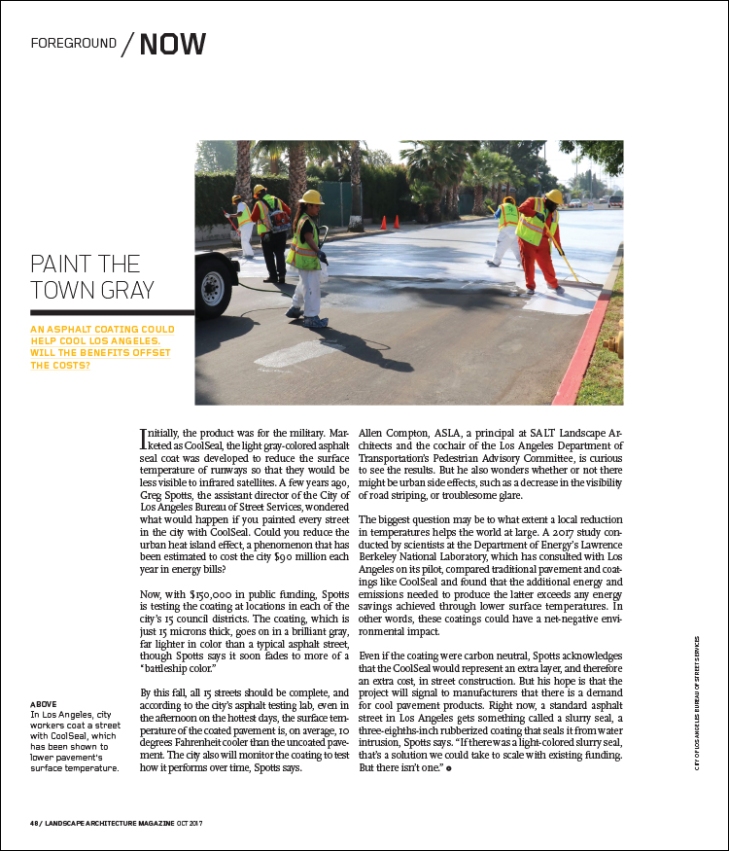BY TIMOTHY A. SCHULER

An asphalt coating could help cool Los Angeles. Will the benefits offset the costs?
FROM THE OCTOBER 2017 ISSUE OF LANDSCAPE ARCHITECTURE MAGAZINE.
Initially, the product was for the military. Marketed as CoolSeal, the light gray-colored asphalt seal coat was developed to reduce the surface temperature of runways so that they would be less visible to infrared satellites. A few years ago, Greg Spotts, the assistant director of the City of Los Angeles Bureau of Street Services, wondered what would happen if you painted every street in the city with CoolSeal. Could you reduce the urban heat island effect, a phenomenon that has been estimated to cost the city $90 million each year in energy bills?
Now, with $150,000 in public funding, Spotts is testing the coating at locations in each of the city’s 15 council districts. The coating, which is just 15 microns thick, goes on in a brilliant gray, far lighter in color than a typical asphalt street, though Spotts says it soon fades to more of a “battleship color.”
By this fall, all 15 streets should be complete, and according to the city’s asphalt testing lab, even in the afternoon on the hottest days, the surface temperature of the coated pavement is, on average, 10 degrees Fahrenheit cooler than the uncoated pavement. The city also will monitor the coating to test how it performs over time, Spotts says.
Allen Compton, ASLA, a principal at SALT Landscape Architects and the cochair of the Los Angeles Department of Transportation’s Pedestrian Advisory Committee, is curious to see the results. But he also wonders whether or not there might be urban side effects, such as a decrease in the visibility of road striping, or troublesome glare.
The biggest question may be to what extent a local reduction in temperatures helps the world at large. A 2017 study conducted by scientists at the Department of Energy’s Lawrence Berkeley National Laboratory, which has consulted with Los Angeles on its pilot, compared traditional pavement and coatings like CoolSeal and found that the additional energy and emissions needed to produce the latter exceeds any energy savings achieved through lower surface temperatures. In other words, these coatings could have a net-negative environmental impact.
Even if the coating were carbon neutral, Spotts acknowledges that the CoolSeal would represent an extra layer, and therefore an extra cost, in street construction. But his hope is that the project will signal to manufacturers that there is a demand for cool pavement products. Right now, a standard asphalt street in Los Angeles gets something called a slurry seal, a three-eighths-inch rubberized coating that seals it from water intrusion, Spotts says. “If there was a light-colored slurry seal, that’s a solution we could take to scale with existing funding. But there isn’t one.”
Timothy A. Schuler, the editor of NOW, can be reached at timothyaschuler@gmail.com and on Twitter @Timothy_Schuler.


